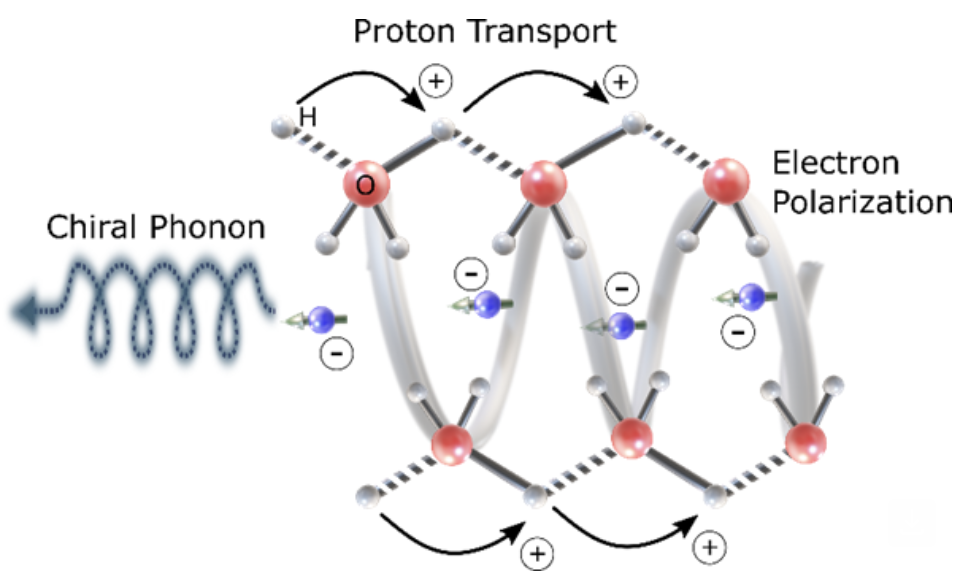Insider Brief
- A new study from Hebrew University shows that proton transfer in biological systems is influenced by electron spin, revealing a quantum component to a fundamental life process.
- Researchers found that injecting electrons with specific spin orientations into lysozyme crystals altered proton mobility, linking the effect to molecular chirality and the Chiral Induced Spin Selectivity (CISS) phenomenon.
- The findings suggest energy and information transfer in living systems may be more selective and controllable than previously thought, with implications for quantum biology and bio-inspired technologies.
- Image: A schematic toy model. The proton transport is accompanied by electron polarization in chiral media. (Naama Goren)
Proton movement in biological systems—long understood as a purely chemical process—may also be driven by quantum mechanics, according to a new study from the Hebrew University of Jerusalem. The findings suggest that the spin of electrons, a fundamental quantum property, can directly influence the ability of protons to move through biological molecules, offering a deeper understanding of life’s basic energy processes and unlocking potential applications in medicine and nanotechnology.
The study, published in Proceedings of the National Academy of Sciences, marks the first time scientists have demonstrated that proton transfer is linked to electron spin when measured in chiral biological environments. This challenges decades of biochemical assumptions and places quantum effects like spin selectivity at the center of cellular energy transfer.
The research was led by Naama Goren and Professor Yossi Paltiel from Hebrew University’s Department of Applied Physics and Nano Center. It involved a multidisciplinary team including Professor Ron Naaman from the Weizmann Institute of Science and Professor Nurit Ashkenasy from Ben-Gurion University. The scientists examined lysozyme crystals—a type of enzyme found in many organisms—to investigate how electrons and protons behave under controlled experimental conditions.
Traditionally, scientists believed that protons in living systems traveled through a hopping mechanism between water molecules and amino acids. But this model ignored the role of quantum spin—a property describing how electrons behave like tiny magnets. The new experiments showed that when electrons were injected into the lysozyme crystals with a specific spin orientation, they dramatically affected the ability of protons to pass through the material.
When electrons with the “wrong” spin were introduced, the researchers observed a noticeable reduction in proton mobility. The mechanism behind this phenomenon appears to be linked to the excitation of so-called chiral phonons—vibrational movements in the molecular lattice that mediate the coupling between electron spin and proton movement. These results align with a known effect in quantum chemistry called Chiral Induced Spin Selectivity (CISS), which explains how molecules with a particular handedness or twist interact differently with electrons of varying spin.
The broader implication is that energy and information transfer in biological systems may be more selective and controllable than previously thought. “Our findings show that the way protons move in biological systems isn’t just about chemistry — it’s also about quantum physics,” Goren said in the university’s release.
Professor Paltiel said the coupling between electron spin and proton mobility could pave the way for new kinds of bio-inspired technologies and mechanisms for controlling information transfer within cells.
The research was conducted by an international team spanning institutions in Israel and Switzerland, including Hebrew University’s Center for Nanoscience and Nanotechnology, Ben-Gurion University’s Ilse Katz Institute, and EPFL in Lausanne. Structural biology expertise was contributed by Oded Livnah and Yael Eisenberg-Domovich at Hebrew University, with plant sciences insights from Professor Nir Keren.
This discovery not only reshapes how scientists view biological charge transport but also raises new questions about how deeply quantum mechanics is embedded in the processes of life. The study suggests that biological systems might be leveraging quantum principles in ways science is only beginning to understand.
While the experimental results are compelling, limitations remain. The experiments were performed on purified lysozyme crystals under lab conditions, and it’s unclear how the observed effects play out in the complex environments inside living cells. Future research will be needed to determine whether similar spin-dependent proton transport mechanisms occur in more dynamic biological systems and whether they play a functional role in health or disease.
Nonetheless, the study opens new paths for research and technology development. If proton transfer can be tuned by manipulating electron spin, scientists may one day design quantum-based biological sensors, energy devices, or even therapies that operate with unprecedented precision.
By bridging the long-divided fields of quantum physics and biochemistry, the team’s work contributes to a growing body of research that sees life not just as a chemical phenomenon—but also a quantum one.
The full study, “Coupling between electrons’ spin and proton transfer in chiral biological crystals,” is available at PNAS.




0 Comments